Human Orbital Spaceflights
![]()
International Flight No. 195STS-84Atlantis (19)84th Space Shuttle missionUSA |
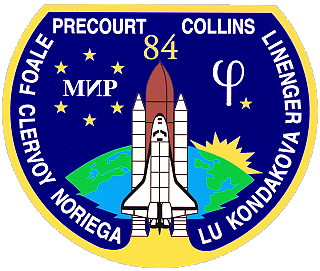 |
 |
|
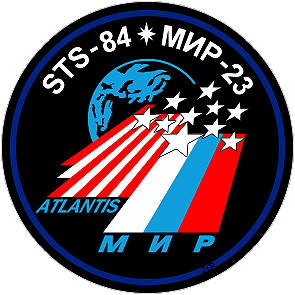 |
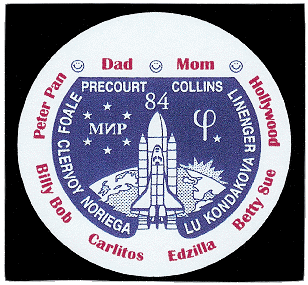 |
||
![]()
Launch, orbit and landing data
walkout photo |
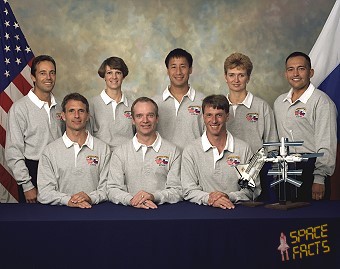 |
|||||||||||||||||||||||||||||||||
alternative crew photo |
alternative crew photo |
|||||||||||||||||||||||||||||||||
alternative crew photo |
||||||||||||||||||||||||||||||||||
alternative crew photo |
||||||||||||||||||||||||||||||||||
Crew
| No. | Surname | Given names | Position | Flight No. | Duration | Orbits | |
| 1 | Precourt | Charles Joseph | CDR | 3 | 9d 05h 19m 55s | 145 | |
| 2 | Collins | Eileen Marie "MOM" | PLT | 2 | 9d 05h 19m 55s | 145 | |
| 3 | Clervoy | Jean-François | MS-1, PLC, EV-1 | 2 | 9d 05h 19m 55s | 145 | |
| 4 | Noriega | Carlos Ismael | MS-2, IV-1, FE | 1 | 9d 05h 19m 55s | 145 | |
| 5 | Lu | Edward Tsang | MS-3, EV-2 | 1 | 9d 05h 19m 55s | 145 | |
| 6 | Kondakova | Yelena Vladimirovna | MS-4 | 2 | 9d 05h 19m 55s | 145 | |
| 7 | Foale | Colin Michael | MS-5 | 4 | 144d 13h 47m 22s | 2291 |
Crew seating arrangement
|
 |
|
||||||||||||||||||||||||||||||||
Backup Crew
|
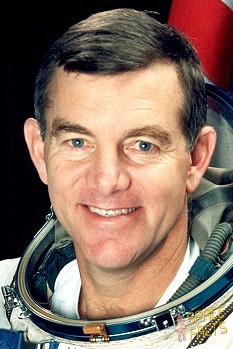 |
||||||||||
Hardware
| Orbiter : | OV-104 (19.) |
| SSME (1 / 2 / 3): | 2032 (6.) / 2031 (15.) / 2029 (15.) |
| SRB: | BI-087 / RSRM 60 |
| ET: | ET-85 (LWT-78) |
| OMS Pod: | Left Pod 03 (23.) / Right Pod 04 (19.) |
| FWD RCS Pod: | FRC 4 (19.) |
| RMS: | - |
| EMU: | EMU No. 3006 (PLSS No. 1006) / EMU No. 3013 (PLSS No. 1013) |
Flight
|
Launch from Cape Canaveral (KSC) and
landing on Cape Canaveral (KSC), Runway 33. This was the sixth of nine planned missions to Mir and the third one involving an exchange of U.S. astronauts. Astronaut Jerry Linenger, who was on Mir since January 15, 1997, was replaced by astronaut Michael Foale. He spent more than four months on Mir. He returned to Earth on Space Shuttle Mission STS-86, launched in September 1997. Atlantis again carried the SPACEHAB module in the payload bay of the orbiter. The double module configuration housed experiments to be performed by Atlantis' crew along with logistics equipment to be transferred to Mir. The prior Shuttle-Mir missions were STS-71, STS-74, STS-76, STS-79 and STS-81. The current Mir-23 mission began when cosmonauts Vasili Tsibliyev and Aleksandr Lazutkin and German Research Cosmonaut Reinhold Ewald of DARA were launched on February 10, 1997, in Soyuz TM-25 and docked with the Mir two days later. Jerry Linenger began his stay on the orbiting Russian facility with the Mir-22 crew in mid-January with the docking of STS-81. He became a member of the Mir-23 crew and continued his science investigations when the Mir-22 crew and Reinhold Ewald returned to Earth on March 02, 1997 with Soyuz TM-24 spacecraft. After Jerry Linenger and Michael Foale completed their handover, Michael Foale worked with the Mir-23 crew until the arrival of Mir-24 cosmonauts Anatoli Soloviyov and Pavel Vinogradov with Soyuz TM-26 in August 1997. After the Mir-23 crew returned to Earth in Soyuz TM-25, Michael Foale completed his tour with the Mir-24 crew. About two hours before the scheduled docking time on Flight Day Three of the mission, Atlantis reached a point about eight nautical miles (14.8 km) behind the Mir space station and conducted a Terminal Phase Initiation (TI) burn, beginning the final phase of the rendezvous. Atlantis closed the final eight nautical miles (14.8 km) to Mir during the next orbit. As Atlantis approaches, the shuttle's rendezvous radar system began tracking Mir and providing range and closing rate information to Atlantis. Atlantis' crew also began air-to-air communications with the Mir crew using a VHF radio. As Atlantis reached close proximity to Mir, the Trajectory Control Sensor, a laser ranging device mounted in the payload bay, supplemented the shuttle's onboard navigation information by supplying additional data on the range and closing rate. As Atlantis closed in on the Mir, the shuttle had the opportunity for four small successive engine firings to fine-tune its approach using its onboard navigation information. Identical to prior Mir dockings, Atlantis aimed for a point directly below Mir, along the Earth radius vector (R-Bar), an imaginary line drawn between the Mir center of gravity and the center of Earth. Approaching along the R-Bar, from directly underneath the Mir, allows natural forces to assist in braking Atlantis' approach. During this approach, the crew began using a handheld laser ranging device to supplement distance and closing rate measurements made by other shuttle navigational equipment. The manual phase of the rendezvous began just as Atlantis reached a point about a half-mile (900 meters) below Mir. Commander Charles Precourt flew the shuttle using the aft flight deck controls as Atlantis began moving up toward Mir. Because of the approach from underneath Mir, Charles Precourt had to perform very few braking firings. However, if such firings were required, the Shuttle's jets were used in a mode called "Low-Z", a technique that uses slightly offset jets on Atlantis' nose and tail to slow the spacecraft rather than firing jets pointed directly at Mir. This technique avoids contamination of the space station and its solar arrays by exhaust from the shuttle steering jets. Using the centerline camera fixed in the center of Atlantis' docking mechanism, Charles Precourt centered Atlantis' docking mechanism with the Docking Module mechanism on Mir, continually refining this alignment as he approached within 300 feet (91.4 meters) of the station. At a distance of about 30 feet (9.14 meters) from docking, Charles Precourt stopped Atlantis and held stationkeep momentarily to adjust the docking mechanism alignment, if necessary. At that time, a final go or no-go decision to proceed with the docking was made by flight control teams in both Houston and Moscow. When Atlantis proceeded with docking, the shuttle crew used ship-to-ship communications with Mir to inform the Mir crew of the Shuttle's status and to keep them informed of major events, including confirmation of contact, capture and the conclusion of damping. Damping, the halt of any relative motion between the two spacecraft after docking, was performed by shock absorber-type springs within the docking device. Mission Specialist Jean-François Clervoy had to oversee the operation of the Orbiter Docking System from onboard Atlantis. STS-84 docking with Mir occurred on May 17, 1997 at 02:33 UTC above the Adriatic Sea. Hatches between two spacecraft opened at 08:25 UTC May 17, 1997. Greetings exchanged between STS-84 crew and Mir-23 Commander Vasili Tsibliyev, Flight Engineer Aleksandr Lazutkin and Jerry Linenger, followed by a safety briefing. Jerry Linenger and Michael Foale officially traded places at 14:15 UTC. STS-84 involved the transfer of 3,318 kilograms (7,310 lb) of water and logistics to and from the Mir. During the docked phase, 465 kilograms (1,030 lb) of water, 383.2 kilograms (845 lb) of U.S. science equipment, 1,168.6 kilograms (2,576 lb) of Russian logistics along with 178.1 kilograms (393 lb) of miscellaneous material were transferred to Mir. Returning to Earth aboard Atlantis were 407.1 kilograms (898 lb) of U.S. science material, 531.2 kilograms (1,171 lb) of Russian logistics, 14 kilograms (31 lb) of ESA material and 170.7 kilograms (376 lb) of miscellaneous material. Transfer of items to and from Mir proceeded smoothly and was completed ahead of schedule. One of first items transferred to station was an Elektron oxygen-generating unit. Altogether about 249 items were moved between the two spacecraft, and about 450 kilograms (990 lb) of water moved to Mir, for a total of about 3,400 kilograms (7,500 lb) of water, experiment samples, supplies and hardware. The Mir-23 mission began when the cosmonaut crew launched on February 10, 1997, in Soyuz TM-25 and docked with the Mir two days later. Jerry Linenger joined the Mir-22 crew with the January 14, 1997 docking of Atlantis during Mission STS-81. The return of Atlantis on STS-84 concluded some experiments, continued others and commenced still others. Data gained from the mission will supply insight for the planning and development of the International Space Station, Earth-based sciences of human and biological processes, and the advancement of commercial technology. The research program conducted by Michael Foale featured 35 investigations total (33 on Mir, two on STS-84, and another preflight/postflight) in six disciplines: advanced technology, Earth observations and remote sensing, fundamental biology, human life sciences, space station risk mitigation, and microgravity sciences. Twenty-eight of these were conducted during previous missions and were to be continued, repeated or completed during Michael Foale's stay. Seven new experiments were planned in biological and crystal growth studies and materials processing. Earth sciences research in ocean biochemistry, land surface hydrology, meteorology, and atmospheric physics and chemistry also were performed. Observation and documentation of transient natural and human-induced changes were accomplished with the use of passive microwave radiometers, a visible region spectrometer, a side-looking radar, and hand-held photography. Earth orbit allowed for documentation of atmospheric conditions, ecological and unpredictable events, and seasonal changes over long time periods. Fundamental biology research continued developmental investigations that study the effects of the space environment on the biological systems of plants. Prolonged exposure to microgravity provides an ideal opportunity to determine the role gravity has on cell regulation and how this affects development and growth. Investigations under this discipline will also characterize the internal radiation environment of the Mir space station. Human life sciences research consisted of investigations that focus on the crewmember's adaptation to weightlessness in terms of skeletal muscle and bone changes, psychological interactions, immune system function, and metabolism. In addition, environmental factors such as water quality, air quality, surface assessment for microbes, and crew microbiology were assessed. These ambitious investigations continued the characterization of the integrated human responses to a prolonged presence in space. Space science research continued with the externally mounted Mir Sample Return Experiment (MSRE) and Particle Impact Experiment (PIE) payloads. These experiments continued to collect interstellar and interplanetary space particles to further our understanding of the origin and evolution of planetary systems and life on Earth. Environmental Radiation Measurements: Exposure of crew, equipment, and experiments to the ambient space radiation environment in low Earth orbit poses one of the most significant problems to long term space habitation. As part of the collaborative NASA/Mir Science program, a series of measurements were compiled of the ionizing radiation levels aboard Mir. During the mission, radiation was measured in six separate locations throughout the Mir using a variety of passive radiation detectors. This experiment continued on later missions, where measurements will be used to map the ionizing radiation environment of Mir. These measurements will yield detailed information on spacecraft shielding in the 51.6-degree-orbit of the Mir. Comparisons were made with predictions from space environment and radiation transport models. Greenhouse-Integrated Plant Experiments: The microgravity environment of the Mir space station provided researchers an outstanding opportunity to study the effects of gravity on plants, specifically dwarf wheat. The greenhouse experiment determined the effects of space flight on plant growth, reproduction, metabolism, and production. By studying the chemical, biochemical, and structural changes in plant tissues, researchers hoped to understand how processes such as photosynthesis, respiration, transpiration, stomatal conductance, and water use are affected by the space station environment. This study was an important area of research, due to the fact that plants could eventually be a major contributor to life support systems for space flight. Plants produce oxygen and food, while eliminating carbon dioxide and excess humidity from the environment. These functions are vital for sustaining life in a closed environment such as the Mir or the International Space Station. Human Life Sciences: The task of safely keeping men and women in space for long durations, whether they are doing research in Earth orbit or exploring other planets in our solar system, requires continued improvement in our understanding of the effects of space flight factors on the ways humans live and work. The Human Life Sciences (HLS) project had a set of investigations planned for the Mir-24/NASA 5 mission to determine how the body adapts to weightlessness and other space flight factors, including the psychological and microbiological aspects of a confined environment and how they readapt to Earth's gravitational forces. The results of these investigations will guide the development of ways to minimize any negative effects so that crewmembers can remain healthy and efficient during long flights, as well as after their return to Earth. Protein Crystal Growth (PCG) experiments were conducted in three facilities - the Gaseous Nitrogen Dewar (GND) facility, the Diffusion-Controlled Crystallization Apparatus for Microgravity (DCAM) facility and the Second-Generation Vapor Diffusion Apparatus (VDA-2) facility. Other activities conducted during the mission included investigations using the Biorack facility, located in the SPACEHAB Double Module in Atlantis’s payload bay, a photo survey of Mir during docked operations, environmental air samplings and radiation monitoring. Once Atlantis was ready to undock from Mir on May 21, 1997, the initial separation was performed by springs that gently pushed the shuttle away from the docking module. Both the Mir and Atlantis were in a mode called "free drift" during the undocking, a mode that has the steering jets of each spacecraft shut off to avoid any inadvertent firings. Once the docking mechanisms springs have pushed Atlantis away to a distance of about two feet (61 centimeters) from Mir, where the docking devices were clear of one another, Atlantis steering jets were turned back on and fired in the Low-Z mode to begin slowly moving away from Mir. For the STS-84 mission, Atlantis continued away from Mir until it reached a distance of 3,000 feet (914 meters) below the Mir in order to test a European laser docking sensor. Unlike previous Shuttle-Mir flights, there was no fly-around of the station for photo documentation. When Atlantis reached the 3,000-foot (914 meters) distance, instead of firing jet thrusters to perform a separation maneuver, the Shuttle depended on the natural forces of one spacecraft being in a lower orbit than another which will cause the Shuttle to move ahead of the Mir. New ESA-developed technology was tested during the Shuttle's approach and departure from Mir. A GPS receiver and an optical rendezvous sensor on the Shuttle, together with equipment already installed on Mir, were operated for the first time in space in an enactment of how ESAs unmanned Automated Transfer Vehicle (ATV) will approach and depart the International Space Station when it delivers supplies to it early in the next century. During the long-range approach to Mir (starting 3 hours before docking), ESAs European Proximity Operations Sensor GPS receivers on Atlantis and Mir received data from Navstar Global Positioning Satellites on the position of the other craft. The accuracy of that relative navigational data was later compared with true data from the Shuttles rendezvous radar. When the Shuttle was at 170 feet (51.8 meters) from Mir, the short-range experiment began. Navigation was handed over to the optical rendezvous sensor. Data again were later be compared to true figures, this time supplied by the NASA Trajectory Control System (TCS), a laser ranging device in the payload bay. |
Note
Photos / Graphics
 |
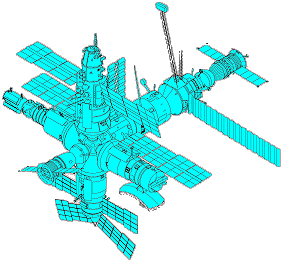 |
 |
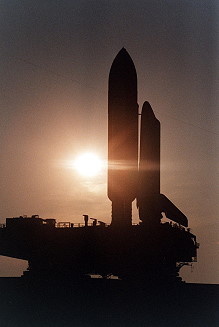 |
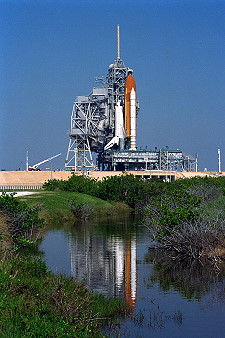 |
 |
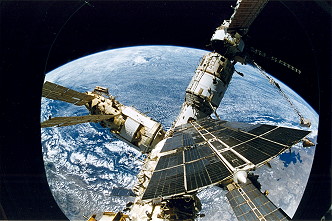 |
 |
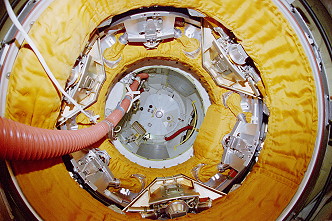 |
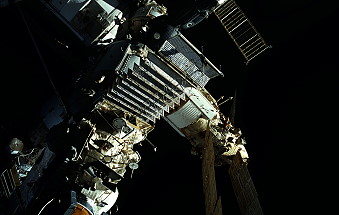 |
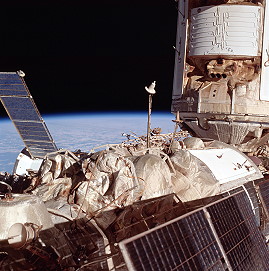 |
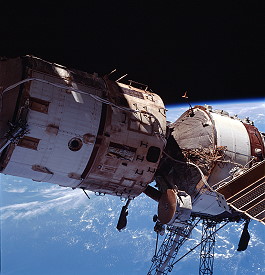 |
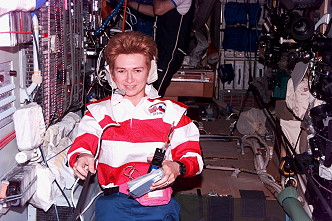 |
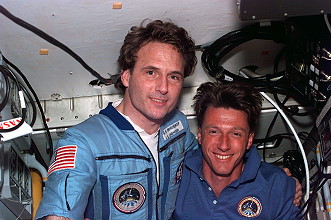 |
 |
 |
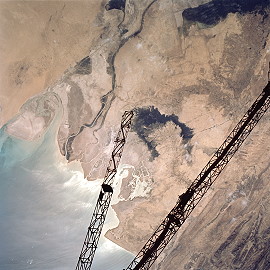 |
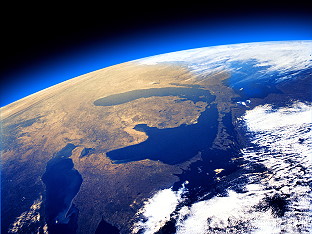 |
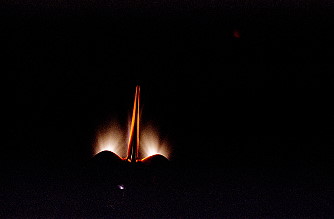 |
 |
| © |  |
Last update on March 27, 2020.  |
 |